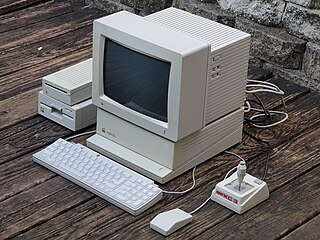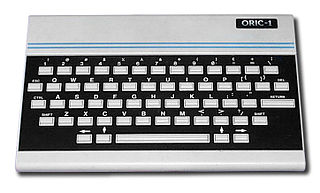
The RadioShack TRS-80 Color Computer, later marketed as the Tandy Color Computer, is a series of home computers developed and sold by Tandy Corporation. Despite sharing a name with the earlier TRS-80, the Color Computer is a completely different system and a radical departure in design based on the Motorola 6809E processor rather than the Zilog Z80 of earlier models.

Video Graphics Array (VGA) is a video display controller and accompanying de facto graphics standard, first introduced with the IBM PS/2 line of computers in 1987, which became ubiquitous in the IBM PC compatible industry within three years. The term can now refer to the computer display standard, the 15-pin D-subminiature VGA connector, or the 640 × 480 resolution characteristic of the VGA hardware.

The Apple IIGS is a 16-bit personal computer produced by Apple Computer. It is the fifth and most powerful of the Apple II family. It is compatible with earlier Apple II models, but has a Macintosh look and feel, and resolution and color similar to the Amiga and Atari ST. The "GS" in the name stands for "Graphics and Sound", referring to its enhanced multimedia hardware, especially its state-of-the-art audio.
MSX BASIC is a dialect of the BASIC programming language. It is an extended version of Microsoft's MBASIC Version 4.5, adding support for graphic, music, and various peripherals attached to MSX microcomputers. Generally, MSX BASIC is designed to follow GW-BASIC, released the same year for IBM PCs and clones. During the creation of MSX BASIC, effort was made to make the system flexible and expandable.

The Color Graphics Adapter (CGA), originally also called the Color/Graphics Adapter or IBM Color/Graphics Monitor Adapter, introduced in 1981, was IBM's first color graphics card for the IBM PC and established a de facto computer display standard.

The FM Towns is a Japanese personal computer built by Fujitsu from February 1989 to the summer of 1997. It started as a proprietary PC variant intended for multimedia applications and PC games, but later became more compatible with IBM PC compatibles. In 1993, the FM Towns Marty was released, a game console compatible with existing FM Towns games.

The TMS9918 is a video display controller (VDC) manufactured by Texas Instruments, in manuals referenced as "Video Display Processor" (VDP) and introduced in 1979. The TMS9918 and its variants were used in the ColecoVision, CreatiVision, Memotech MTX, MSX, NABU Personal Computer, SG-1000/SC-3000, Spectravideo SV-318, SV-328, Sord M5, Tatung Einstein, TI-99/4, Casio PV-2000, Coleco Adam, Hanimex Pencil II, and Tomy Tutor.
In computing, indexed color is a technique to manage digital images' colors in a limited fashion, in order to save computer memory and file storage, while speeding up display refresh and file transfers. It is a form of vector quantization compression.

The PC-6000 series is a series of 8-bit home computers introduced in November 1981 by NEC Home Electronics. There are several models in this series, such as the PC-6001, the PC-6001 MK2 and the PC-6001 MK2 SR. There is also an American version, called the NEC TREK or NEC PC-6001A.

Oric was a brand of home computers sold in the 1980s by Tangerine Computer Systems. Tangerine was based in the United Kingdom and sold their computers primarily in Europe. All computers in the Oric line were based on the MOS Technology 6502A microprocessor.
Chromatics Inc. was a color graphics display manufacturer based in Tucker, Georgia. Their systems predated the personal computer era of inexpensive graphics displays, and were typically used as peripheral devices, connected to a mainframe or minicomputer. In some configurations, a Chromatics graphics terminal could be used as a stand-alone workstation, with disk drives and an operating system.
The TC 3256 or Timex Computer 3256 was a 1987 computer created by Timex of Portugal, a branch of Timex Corporation.

The Personal System/55 (パーソナルシステム/55) or PS/55 is a personal computer series released from IBM Japan in 1987.

The Orion-128 is a DIY computer designed in Soviet Union. It was featured in the Radio magazine in 1990, other materials for the computer were published until 1996. It was the last Intel 8080-based DIY computer in Russia.

Toshiba Pasopia is a computer from manufacturer Toshiba, released in 1981 and based around a Zilog Z80 microprocessor. This is not to be confused with the Toshiba Pasopia IQ, a similar named line of MSX compatible computers.
Toshiba Pasopia 16 or PA7020 is an IBM PC compatible computer from manufacturer Toshiba, released in 1982 and based around a Intel 8088-2 microprocessor running at 6 MHz.










